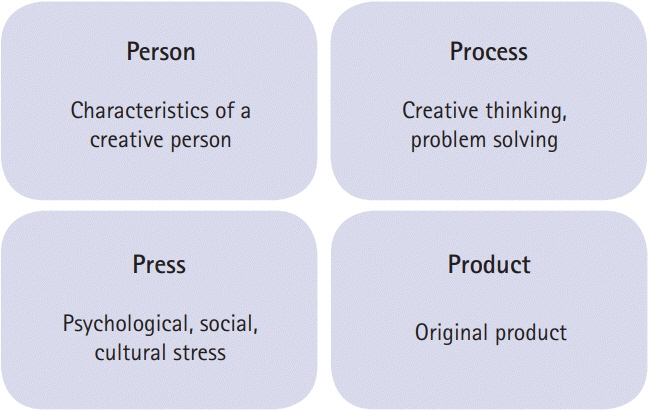Yeungnam Univ J Med.
2020 Apr;37(2):79-83. 10.12701/yujm.2019.00458.
Creativity in medical education: concepts related to creative capacity
- Affiliations
-
- 1Department of Medical Humanities, Yeungnam University College of Medicine, Daegu, Korea
- KMID: 2501413
- DOI: http://doi.org/10.12701/yujm.2019.00458
Abstract
- In the 21st-century postmodernism era, which represents diversity and relativity, one of the most essential elements in the field of education is to strengthen individual human values. Accordingly, we must focus on developing capacity in order to adapt to change. It is clear that the medical field maximizes the need for new judgments to solve life-related problems constantly, and this problem-solving capacity is an essential skill for a physician. Problem-solving capacity can be achieved simultaneously with creativity to apply them in an appropriate manner based on standardized expertise and well-trained skills. Creativity is also a key element that medical education is currently pursuing. Many studies on creativity have resulted in confusion and misunderstandings on the concept of creativity due to similar terms and varied definitions, such as creation, innovation, etc. In this study, we attempt to identify the importance of creativity in medical education by comparing and organizing concepts related to creative capacity.
Keyword
Figure
Cited by 1 articles
-
A study on the mental health of students at a medical school during COVID-19 outbreak: a retrospective study
Yu Ra Kim, Hye Jin Park, Bon-Hoon Koo, Ji Young Hwang, Young Hwan Lee
J Yeungnam Med Sci. 2022;39(4):314-321. doi: 10.12701/jyms.2022.00437.
Reference
-
References
1. Lee YH. Reflections and tasks on our medical education. Healthc Policy Forum. 2019; 17(2):45–50.2. Harden RM, Sowden S, Dunn WR. Educational strategies in curriculum development: the SPICES model. Med Educ. 1984; 18:284–97.
Article3. Baek SH. Future of medical education. Korean Med Educ Rev. 2008; 10:1–8.4. Torrance EP. The millennium: a time for looking forward and looking backward. Korean J Think Probl Solving. 2000; 19:5–19.5. Guilford JP. Creativity. Am Psychol. 1950; 5:444–54.
Article6. Rhodes M. An analysis of creativity. Phi Delta Kappan. 1961; 42:305–10.7. Guilford JP. The nature of human intelligence. New York: McGraw-Hill;1967.8. Torrance EP. Why fly? A philosophy of creativity. Norwood (NJ): Ablex;1995.9. Kim YC. Theory and development of creativity. Seoul (KR): Education Science Publishers;2010.10. Murray HA. Explorations in personality: a clinical and experimental study of fifty men of college age. Oxford (UK): Oxford University Press;1938.11. Csikszentmihalyi M. Creativity: flow and the psychology of discovery and invention. New York: HarperCollins Publishers;1996.12. Kaufman JC. Creativity 101. 2nd ed. New York: Springer Publishing Company;2016.13. Kaufman JC, Beghetto RA. Beyond big and little: the Four C Model of creativity. Rev Gen Psychol. 2009; 13:1–12.
Article14. Cho YS, Jeong JE. An analytical study on studies of creativity education in Korea: focusing on categories and levels of creativity. J Gift/Talent Educ. 2012; 22:333–52.
Article15. Park YT. Star of creativity. Seoul (KR): Hakjisa;2002.16. Jeong HP. Introduction to new education. Seoul (KR): Education Science Publishers;2002.17. Kim YC. Creativity: theory and education of potential. Seoul (KR): Yunsung Publishers;2017.18. Lytton H. Creative and education. London: Routledge & Kegan Paul;1971.19. Barrow R. Plato and education. London: Routledge & Kegan Paul;1976.
- Full Text Links
- Actions
-
Cited
- CITED
-
- Close
- Share
- Similar articles
-
- Creativity Development Programs in Medical Education
- Psychoanalysis and Literature: The Unconsciousness of the Creative Writers
- Brain Areas Subserving Torrance Tests of Creative Thinking: An Functional Magnetic Resonance Imaging Study
- The impact of elementary school pre-service teachers' perception of diet-related factors on their efficacy in creative dietary teaching
- Psychosocial Approach to the Creative Living of Old Age




